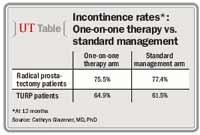Article
Incontinent men gain little from one-on-one therapy
In men with incontinence as a result of prostate surgery, one-on-one sessions by trained therapists do not produce any additional clinical benefit compared with standard management.

Key Points
Toronto-In men with incontinence as a result of prostate surgery, one-on-one sessions by trained therapists do not produce any additional clinical benefit compared with standard management, according to data from a multicenter study.
Researchers from several institutions in the United Kingdom and Canada screened men who had urinary incontinence at 6 weeks after a radical prostatectomy or transurethral resection of prostate (TURP). They hypothesized that active conservative therapy delivered by a specialist continence physiotherapist or nurse would lead to an absolute difference of 15% between arms in incontinence rates. All men received a lifestyle advice leaflet.

Men received four personal sessions with a therapist over a period of 3 months that included pelvic floor muscle training, bladder training, and urge suppression.
"We are not saying the exercises don't work," said Dr. Glazener, whose study was selected as best clinical abstract at the 2010 joint meeting of the International Continence Society and International Urogynecological Association.
"It was clear that a lot of the men were doing the exercises anyway. There is a culture that exists in which whoever sees men after a radical prostatectomy-be it the doctor or the nurse-tells them to do their pelvic floor exercises."
In addition, men can see for themselves if they are doing a pelvic floor contraction correctly by seeing whether their penis lifts, their testicles retract, and their anus closes up, whereas women do not have the same external signs to be sure they are performing a pelvic contraction correctly, Dr. Glazener said.
The other aspect of one-on-one training is providing emotional and psychological support and feedback, she added.
"I don't know how much of that makes up the one-on-one consultation, but the overall consultation did not make a difference in incontinence rates," Dr. Glazener said.
Funds would be better used elsewhere
Based on their findings, Dr. Glazener and colleagues recommended that funds allocated to pelvic floor muscle training by a trained therapist in a one-to-one fashion for this population of men might be better directed elsewhere.
The investigators also found that if men were incontinent at 6 weeks postoperatively, three-fourths were still incontinent at 1 year. Indeed, 40% had severe incontinence, defined as leaking a moderate to severe amount at least once per day.
"It was startling how many men were still incontinent," said Dr. Glazener.
"If you are leaking a moderate to severe amount once a day, you are wearing a pad. You have a problem in doing your normal, daily activities."





